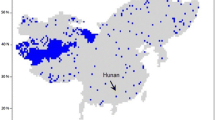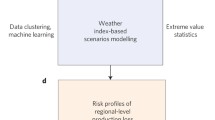Abstract
This study proposes a risk analysis model for the rice production due to climate change in terms of agro-climate indices (i.e., cumulative temperature anomaly, cumulative precipitation anomaly, cumulative sunlight anomaly, cumulative radiation anomaly, and E1 Niño). This risk analysis model is developed by incorporating the multivariate Monte Carlo simulation method, multivariate regression equation, and uncertainty analysis method (advanced first-order second-moment, AFOSM). The study area is composed of 15 counties/cities in Taiwan, East Asia. The data set for the model development and applicability contains 27 years of annual rice productions and agro-climate indices in addition to cultivation areas. Through the proposed risk analysis model, it can be seen that the rice production in Taiwan is especially sensitive to temperature, precipitation, and sunlight. Also, on average, improving performance by reducing insufficient rice risk can rise by 80 % when the rice production increases from 3 × 104 to 3 × 105 tons.








Similar content being viewed by others
References
Amien I, Redjekiningrum P, Kartiwa B, Estinigntyas W (1999) Simulated rice yield as affected by interannual climate variability and possible climate change in Java. Clim Res 12:145–152
Ayinde OE, Ojehomon VET, Daramola FS, Falaki AA (2013) Evaluation of the effects of climate change on rice production in Niger state. Ethiop J Enviro Stud Manag 6:763–777
Chang CH, Yang JC, Tung YK (1997) Incorporate marginal distributions in point estimate methods for uncertainty analysis. J Hydrol Eng 123(3):224–251
Chiang JL, Liu TM (2013) Impact of climate change on paddy field irrigation in southern Taiwan. Paddy Water Environ 11(1–4):311–320
Chiueh YW, Huang CC, Tan CH (2013) Modeling the rice-climate indices in Taiwan. Clim Chang Econ 4(3):1350012-1-19
Chung SO, Nkomozepi T (2012) Uncertainty of paddy irrigation requirement estimated from climate change projections in the Geumho river basin, Korea. Paddy Water Environ 10(3):175–185
Du Toit MA, Prinsloo S, Marthinus A (2001) El Niño-southern oscillation effects on maize production in South Africa: a preliminary methodology study. ASA special publication 63. American Society of Agronomy, Madison
Easterling WE, Chen X, Hays C, Brandle JR, Zhang H (1996) Improving the validation of model-simulated crop yield response to climate change: an application to the EPIC model. Clim Res 6:263–273
Gillig D, McCarl BA (2002) Introduction to computable general equilibrium models (CGE). Department of Agricultural Economics, Texas A & M University. http://ageco.tamu.edu/
Iizumi T, Yokozawa M, Nishimori M (2011) Probability evaluation of climate impact on paddy rice productivity in Japan. Clim Chang 107:391–415
Khan MA, Ansari R, Ali H, Gul B, Nielsen BL (2009) Panicum turgidum: a sustainable feed alternative for cattle in saline areas. Agric Ecosyst Environ 129:542–546
Lee BH, Tung SJ (1998) An investigation on the agrometeorological disasters prevention attitude of the farmers/fisherman in Chiayi area. Chin J Agrometeorol 5(1):49–57
Lindquist J, Kropff MJ (1996) Application of an ecophysiological model for irrigated rice (Oryza sativa)-Echinochloa competition. Weed Sci 44:52–56
Liu PL, Der Kiureghian A (1986) Multivariate distribution models with prescribed marginals covariances. Probab Eng Mech 1(2):105–112
Masutomi Y, Kiyoshi T, Hideo H, Yuzuru M (2009) Impact assessment of climate change on rice production in Asia in comprehensive consideration of process/parameter uncertainty in general circulation models. Agric Ecosyst Environ 31:281–291
Mays LW (2001) Stormwater collection system design handbook. McGraw-Hill, New York
Mendelsohn R, Nordhaus W, Shaw D (1994) The impact of global warming on agriculture: a Ricardian analysis. Am Econ Rev 84(4):753–771
Nataf A (1962) Determination des distributions don’t les marges sontdonnees. Comptes Rendus de l’Académie des sciences 225:42–43
Nordhaus W, Yang Z (1996) A regional dynamic general-equilibrium model of alternative climate change strategies. Am Econ Rev 86(4):741–765
Paik Y (2008) Analytical derivation of reservoir routing and hydrological risk evaluation of detention basins. J Hydrol 352:191–201
Sadeghifar M, Sharafi Z, Safe M (2013) Assessing the effect of sample size on the power of multivariate multiple regression by using Monte Carlo simulation. World Sci J 1(15):175–180
Shahid S (2011) Impact of climate change on irrigation water demand of dry season Boro rice in northwest Bangladesh. Clim Chang 105(3–4):627–645
Tao F, Zhang Z, Liu J, Yokozawa M (2009) Modelling the impact of weather and climate variability on crop productivity over a large area: a new super-ensemble-based probability projection. Agric For Meteorology 149:1266–1278
Tung YK, Mays LW (1981) Risk model for flood levee design. Water Resour Res 17(4):833–841
Tung YK, Yen BC (2005) Hydrosystems engineering uncertainty analysis. ASCE Press, New York
Van Lettersum MK, Donatelli M (2003) Modeling cropping systems: science, software and applications. Eur J Agron 16:309–332
White JW, Hoogenboom G, Kimball BA, Wall GW (2011) Methodologies for simulating impacts of climate change on crop production. Field Crops Res 124:357–368
World Meteorology Organization (WMO) (1966) Guide to climatological practices, WMO No.100. WMO, Geneva
WRMA (2010) Weather indexed insurance for rain on tomato crop in California. http://www.wrma.org/pdf/WeatherIndexedInsuranceTomatoes.pdf. Accessed 12 Nov 2013
Wu SJ, Tung YK, Yang JC (2006) Stochastic generation of hourly rainstorm events. Stoch Environ Res Risk Assess 21(2):1436–3240
Yapha H, Wong KC (2013) Organic rice farming system in Taiwan: a review of technical and economic aspects. 2nd international conference on environment. Agriculture and Food Sciences, Kuala Lumpur, 6–7 May 2013, pp 94–96
Yates D, Strzepek K (1998) Modeling the Nile Basin under climate change. J Hydrol Eng 3(2):98–108
Zhai F, Lin T, Byambadorj E (2009) A general equilibrium analysis of the impact of climate change on agriculture in the People’s Republic of China. Asian Dev Rev 26(1):206–225
Author information
Authors and Affiliations
Corresponding author
Rights and permissions
About this article
Cite this article
Wu, SJ., Chiueh, YW., Lien, HC. et al. Modeling risk analysis for rice production due to agro-climate change in Taiwan. Paddy Water Environ 13, 391–404 (2015). https://doi.org/10.1007/s10333-014-0455-x
Received:
Revised:
Accepted:
Published:
Issue Date:
DOI: https://doi.org/10.1007/s10333-014-0455-x




